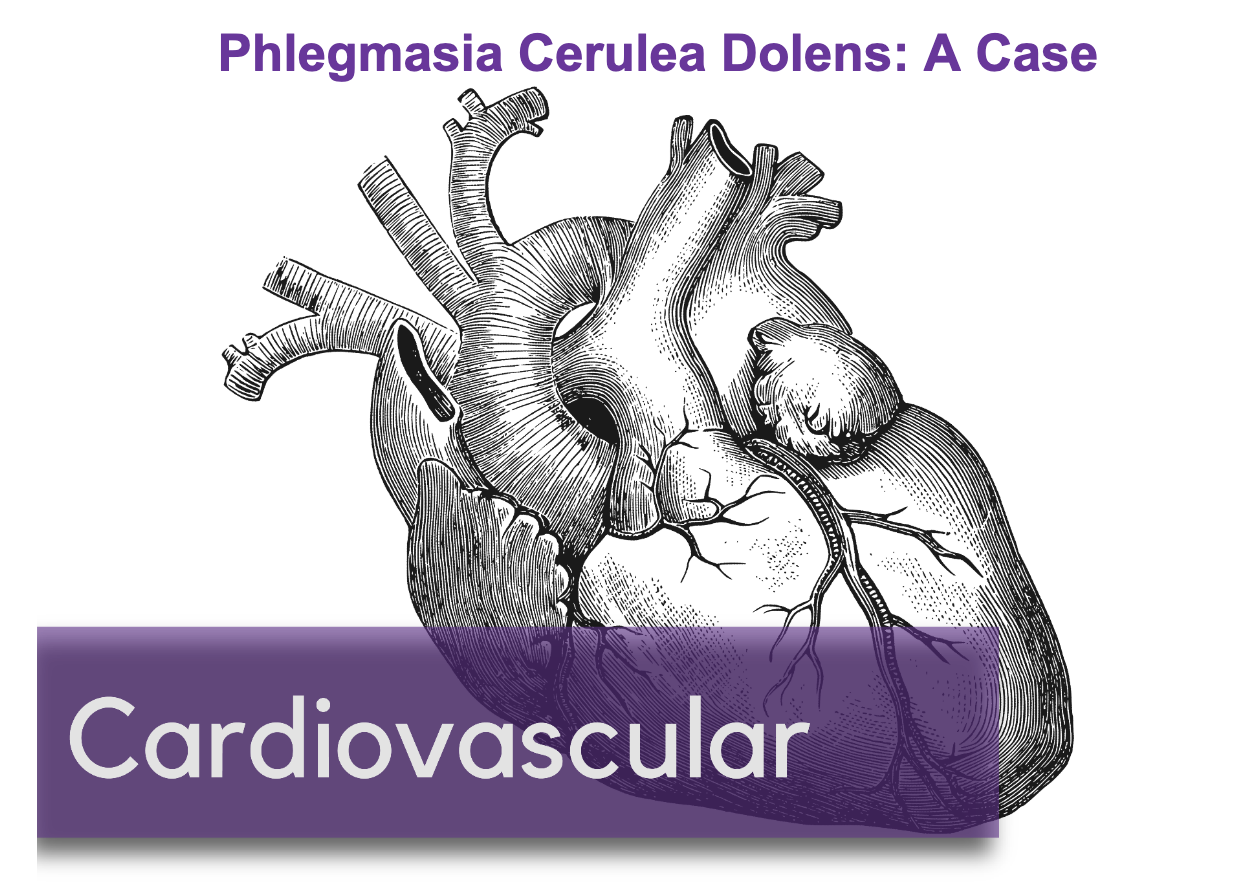Written by: Dean Hayes, MD, (NUEM ‘27) Edited by: Andrew Ugalde, MD (NUEM ‘25)
Expert Commentary by: Seth Trueger, MD, MPH, FACEP
An elderly gentleman with a history of metastatic malignancy presents to the Emergency Department with a chief complaint of right foot pain and rash for 1 day. In triage, the patient's foot is noted to be a deep purple color and the patient is quickly moved to an exam room. Upon initial examination the right foot is cool to the touch and a deep purple discoloration is present on the entire plantar surface and midway up the dorsal surface. Interestingly, both the DP and PT pulse were easily found with a doppler. However, a stat vascular surgery consult was called for concern for an ischemic right foot. Bilateral lower extremity ultrasounds were also ordered as the right leg was substantially more edematous than the left.
Initial lab and imaging workup was notable for a mildly elevated lactate to 2.2, and acute DVT in both the right and left gastrocnemius, popliteal, posterior tibial, peroneal, and soleal veins. Additionally, arterial ultrasound studies demonstrated normal flow and pressure on both left and right lower extremities. In the emergency department, the patient was started on a heparin drip with concern for phlegmasia cerulea dolens (PCD) of the right lower extremity secondary to extensive venous clot burden.
Venous thromboembolism (VTE) is a relatively common pathology seen in the Emergency Department. However, progression of VTE to PCD is a rare occurrence. While the exact incidence of PCD is unknown, one retrospective review from a regional health system found only 22 cases of documented PCD over 10 years. Due to the rarity, there is no precise diagnostic criteria for PCD. However, the generally agreed upon initial cardinal signs of PCD on exam include edema, violaceous discoloration, and pain. These signs are all caused by extensive venous clot burden causing severe venous congestion in both major and collateral veins. This increases hydrostatic pressure leading to the edema noted on presentation. As the disease progresses, capillaries will often become compromised leading to tissue ischemia and gangrene. Additionally, there are case reports of PCD causing compartment syndrome with arterial collapse.
If there is concern for PCD, a stat doppler ultrasound is the preferred initial test. Further imaging such as arteriography or MRI can be used but are not necessary to make a diagnosis. There are several different treatment options for PCD including conservative management, surgical thrombectomy, and catheter directed thrombolytics. Initial treatment in the ED will likely depend on setting and resources, but patients would benefit from an initial heparin drip and stat vascular surgery evaluation to determine best treatment management. Unfortunately, mortality after PCD diagnosis is estimated as high as 40%, particularly if gangrene develops. Additionally, venous valvular incompetence commonly develops secondary to PCD.
The patient in our case was treated with conservative management due to multiple comorbidities and the risk of bleeding secondary to substantial malignant burden. While inpatient, he was transitioned from the heparin drip to Lovenox 1mg/kg BID. Pentoxifylline, a medication used to reduce blood viscosity by reducing red blood cell aggregation, was started at 400 mg TID while inpatient. In the subsequent days the patient went on to develop gangrene of multiple toes and had a skin biopsy that found significant RBC extravasation consistent with venous stasis and increased hydrostatic pressure - findings consistent with PCD. While inpatient, the patient ultimately elected to be discharged home with hospice.
The take home point for ED providers is that while rare, PCD is a life threatening condition that requires prompt diagnosis, quick initiation of a heparin drip and subspecialty consultation for possible surgical intervention. Emergent imaging should be obtained in a patient’s who present with signs of PCD. Duplex ultrasound is reasonable first imaging to study to obtain. If emergent ultrasound is unavailable overnight a CT venogram is another possible imaging modality. Ultimately, due to the high morbidity associated with PCD these patients will need admission or transfer to a center with vascular surgery.
References:
Annamaraju P, Baradhi KM. Pentoxifylline. [Updated 2022 Sep 19]. In: StatPearls [Internet]. Treasure Island (FL): StatPearls Publishing; 2023 Jan-. Available from: https://www.ncbi.nlm.nih.gov/books/NBK559096/
Chaochankit W, Akaraborworn O. Phlegmasia Cerulea Dolens with Compartment Syndrome. Ann Vasc Dis. 2018 Sep 25;11(3):355-357. doi: 10.3400/avd.cr.18-00030. PMID: 30402189; PMCID: PMC6200621.
Erdoes LS, Ezell JB, Myers SI, Hogan MB, LeSar CJ, Sprouse LR 2nd. Pharmacomechanical thrombolysis for phlegmasia cerulea dolens. Am Surg. 2011 Dec;77(12):1606-12.
Gardella L, Faulk JB. Phlegmasia Alba and Cerulea Dolens. [Updated 2022 Oct 3]. In: StatPearls [Internet]. Treasure Island (FL): StatPearls Publishing; 2023 Jan-. Available from: https://www.ncbi.nlm.nih.gov/books/NBK563137/
Mumoli, N., Invernizzi, C., Luschi, R., Carmignani, G., Camaiti, A., & Cei, M. (2012). Phlegmasia cerulea dolens. Circulation, 125(8), 1056-1057.
Said A, Sahlieh A, Sayed L. A comparative analysis of the efficacy and safety of therapeutic interventions in phlegmasia cerulea dolens. Phlebology. 2021 Jun;36(5):392-400. doi: 10.1177/0268355520975581. Epub 2020 Nov 25.
Expert Commentary
Thank you for this nice case presentation of a patient with phlegmasia cerulean dolans. Phelgmasia is a rare, severe presentation of extensive DVT. Phlegmasia alba dolens (clot, white, pain) is the “less severe” variation where the DVT causes pain and blanched skin; phlegmasia cerulea dolens (clot, blue, pain) with essentially overwhelming venous congestions, such that arterial flow is compromised. Both of these cases are severe and quite rare; I have seen less than a handful for whatever that is worth. The mainstays of management are diagnostic venous ultrasound, anticoagulation (either heparin or LMWH is fine), and specialty consultation, ie, vascular surgery and interventional radiology.
In my view, the hardest parts of cases like these is overcoming the skepticism that yes, this is what’s happening. Diffusely painful, swollen legs with either diffuse blanching or cyanosis should prompt a rapid response. These can progress fast and it is easy to be falsely reassured with findings like intact pulses, hemodynamic instability or normal lactate levels. And, these can occur in patients without comorbidities or risk factors. Further, excessive diagnostics such as arterial ultrasound or CTAs can be distractions and should not delay anticoagulation and specialist involvement.
Given the rarity and severity of phlegmasia, I suspect solid data -- particularly to guide interventions -- will be lacking for years to come. (At the time of writing, there are 0 Pubmed results for “RCT phlegmasia”). Catheter-directed therapies seem intuitively promising, and we have few other options with such sick patients, where the risk of limb loss, other severe morbidity and death are so high.
My general approach: a patient with diffusely swollen, painful, and white or blue limbs should prompt immediate venous ultrasound, calls to vascular surgery and IR, and heparinization, in parallel. And again, I suspect the biggest obstacle to rapid treatment is getting over the disbelief that it’s real and here in front of us and we can try to treat it.
Reference
1. Frankel, David, dir. The Devil Wears Prada. Los Angeles, CA: 20th Century Fox; 2006.
Seth Trueger, MD, MPH, FACEP Associate Professor of Emergency Medicine Northwestern University
How To Cite This Post:
[Peer-Reviewed, Web Publication] Hayes, D. Ugalde, A. (2025, July 10). Phlegmasia Cerulea Dolens: A Case. [NUEM Blog. Expert Commentary by Trueger, S]. Retrieved from http://www.nuemblog.com/blog/phlegmasia-cerulea-dolens.













